Hillsborough County Public Schools in Tampa, Fla., ranks as one of the country’s largest school districts with approximately 215,000 students at more than 230 schools. The Student Nutrition Services (SNS) department serves approximately 200,000 meals per day.
To consolidate all student nutrition operations under one roof, the district introduced a new Center for Nutrition and Culinary Services prior to the 2017–18 school year. The facility helps SNS provide quality food with a decreasing skilled labor force and increase revenue by providing catered services and renting out the new event center. The facility also helps SNS combat increasing labor costs through the use of a central kitchen for providing menu items to smaller schools. It also contains costs through better inventory management and reduced food waste, improved administrative efficiencies and foodservice training offered to the school district’s foodservice employees.
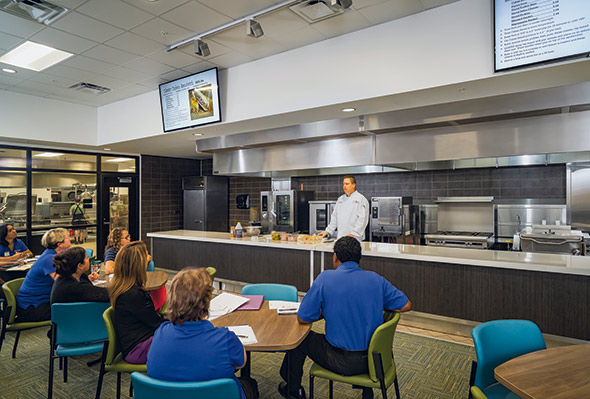
The Center for Nutrition and Culinary Services includes a production kitchen, the district’s SNS administrative offices, and Core Catering, the district’s catering services department. This facility also features The Silo Eatery, an on-site cafe that’s open to the public; an event center that includes a ballroom and smaller event rooms; training rooms; and a chef demonstration kitchen. “We never have had centralized training spaces for foodservice, so this is an exciting feature,” says Mary Kate Harrison, Ph.D., general manager of SNS.
One of the building’s larger features, the culinary kitchen, supports district schools with smaller enrollments — those
serving fewer than 500 students. The district is converting the kitchens at these schools from conventional operations to finishing kitchens. The rollout plan continuously converts small groups of kitchens and will be complete by the end of 2019.
At the individual schools, the finishing kitchens receive bulk meal components that staff can rethermalize, assemble and place on a serving line. “We’re trying to make the schools with finishing kitchens more efficient and operate with fewer staff members,” Harrison says. “Some of the finishing kitchens’ staff responsibilities, such as ordering and keeping production records, have been transferred to the culinary kitchen’s staff. We want staff at the finishing kitchens to focus more on nutrition education and customer service.”
In addition, the culinary kitchen will provide ready-to-serve meals to other sites that have no kitchens, such as charter schools, Boys & Girls Clubs of America and YMCA sites. During the summer, the culinary kitchen supports a variety of summer feeding programs in the community.
The schools with no kitchens receive hot ready-to-service menu items in bulk pans that staff place directly on serving lines. “It isn’t practical to run a full-service kitchen at each of these smaller schools,” Harrison adds. “With the cost and availability of trained employees and managers, it makes more sense to bring food preparation for these schools under one roof.”
In the space allocated to Core Catering, staff prepare food for district functions such as luncheons, breakfast functions, meetings and student-centered events such as reward celebrations. “We’ve catered for large extravagant events and set up the room with draped tables, we’ve rented cocktail-height tables for stand-up events, and we’ve done boxed lunches and breakfasts for more casual events,” Harrison says. The center also has a contract to provide 10,000 emergency meals a day for American Red Cross mobile delivery units. In addition, the center’s service yard contains an emergency generator to enable the center to provide meals to shelters during disasters.
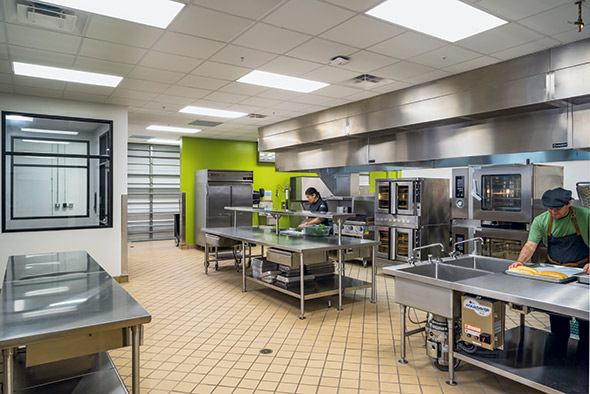 Core Catering, the district’s branded catering service, provides menu items for the center’s catered events as well as off-premises events.
Core Catering, the district’s branded catering service, provides menu items for the center’s catered events as well as off-premises events.
Food Preparation and Delivery
“The center’s kitchen has very good lighting and a good workflow,” Harrison says. “We repurposed equipment from finishing kitchens no longer needed for production. We’re continuing to tweak production as needed, so we left some spaces open under the ventilation hood so we can add equipment.”
Food deliveries arrive at a loading dock where staff transport food to walk-in coolers, a walk-in freezer and dry storage. Three distinct production areas exist: one for school meals, one for bakery and another for catering.
Preparation for school meals takes place in areas with island worktables with sinks. Another area contains another sink for rinsing produce, an air-powered can punch, a vertical cutter/mixer, a buffalo cutter and automatic food slicer.
Hot food production equipment includes two convection ovens, two rotary rack ovens, two combi ovens and a four-burner range. Staff also use a 60-gallon tilting braising pan and a 40-gallon steam kettle.
Food Production and External Kitchen Delivery
Staff prepare hot menu items that they roll into the blast chiller for fast cooling. After food chills to proper safe-handling temperatures, staff store it in a walk-in freezer until transporting it to the schools.
Staff prepare cold menu items in a climate-controlled area and pack them in insulated containers that ship to schools in refrigerated trucks. Drivers deliver ready-to-serve food to schools daily. Bulk food products that go to finishing kitchens leave in refrigerated trucks twice a week.
Warming containers keep food hot for schools without kitchens. Staff assemble these items in an area adjacent to the hot food production area with the intent that on-site school staff can immediately serve menu items as they arrive.
The bakery production staff makes menu items for school meals, catering and The Silo Eatery. Equipment supporting bakery production includes island worktables with sinks, a baker’s table, ingredient bins, a 30-quart mixer, a 60-quart mixer, a proofing cabinet, a pair of double-stacked convection ovens and a proofing cabinet.
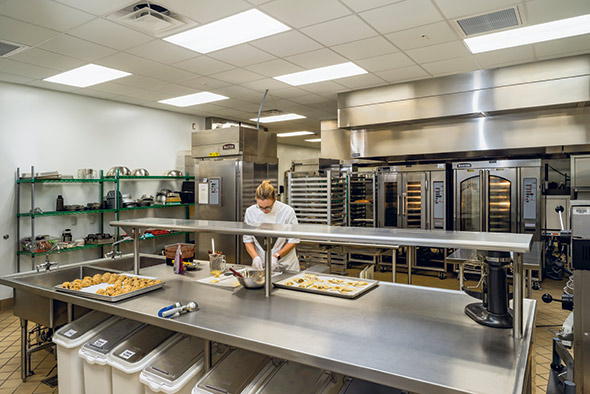 An employee prepares baked goods at the center.
An employee prepares baked goods at the center.
Cooking equipment in the catering production area includes a 6-burner range with an oven beneath, 2 combi ovens, a 40-gallon tilting braising pan and a charbroiler. Additional equipment includes a slicer, vertical cutter/mixer, mobile can rack and dunnage racks. An ice maker with a bin also sits in this area.
A large custom outdoor air unit that supplies makeup air to the production kitchens’ exhaust hoods sits in a service yard used for shipping and deliveries. “This was necessary because the roof has load-bearing limitations,” Harrison says. “The exhaust hoods operate at variable rates depending on what’s cooking below.”
The dishwashing area separates school meal production from catering production. This area contains a disposal, a high-powered pot sink and a flight-type dishwasher repurposed from a school site. A janitor’s area sits nearby.
The Chef Demonstration Kitchen and The Silo Eatery
Foodservice training takes place in three meeting rooms and the chef demonstration kitchen, complete with 56 seats and overhead LED monitors. Instructors prepare menu items in a mini production kitchen that includes a 20-quart mixer, a 30-gallon tilting braising pan, a 10-pan steamer, a 4-burner range with an oven beneath, a convection oven, a combi oven, and several mobile utility carts and pan racks. Windows allow visitors and employees to watch production.
The Silo Eatery offers casual-dining breakfast and lunch. The cafe also provides extra space for catered events.
The cafe houses a small kitchen behind the serving counter. Refrigerated and ambient cases display items for customers, who place orders at the counter. The menu includes sandwiches such as Tampa Cubans, flatbreads, salads, burgers, side dishes and beverages. A cold-top refrigerator, reach-in refrigerator and a freezer store ingredients. Staff prepare hot menu items using a fryer with a floor-mounted dump station and drop-in hot food wells, two high-speed ovens and two high-speed panini grills. Customers can select from two soups daily. Beverages include juices, freshly brewed espresso and other coffee drinks, tea and smoothies made on-site with blenders. A display case showcases cookies, pastries and cakes baked in the center’s kitchen.
The Silo Eatery seats 40, split between indoor and outdoor seating areas. Options inside include tables and chairs, bench seats and bar-height stools.
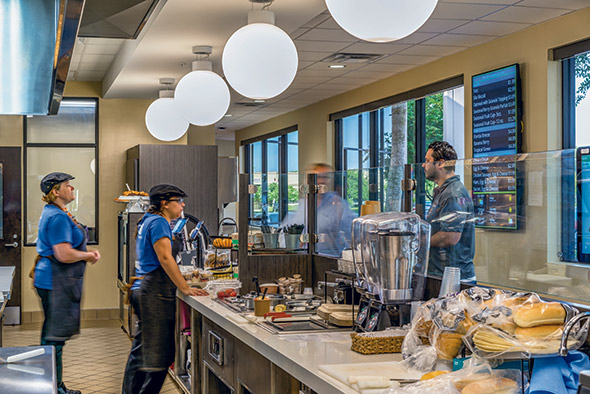 Employees take and assemble orders at The Silo Eatery.
Employees take and assemble orders at The Silo Eatery.
Challenges at the Center
“When going into any type of central production, having drivers on board is critical and can be challenging if you’re down a driver for a day,” Harrison says. “We are hiring drivers who have a dual role. They will be delivering and picking up foodservice equipment from school sites as well as delivering meals when needed.”
At the finishing kitchens, Harrison and the managers continue to explore rescheduling and efficient production throughout the entire day. In the central production facility, she will be adding packaging and sealing equipment to make individual salads and fruit cups more economical.
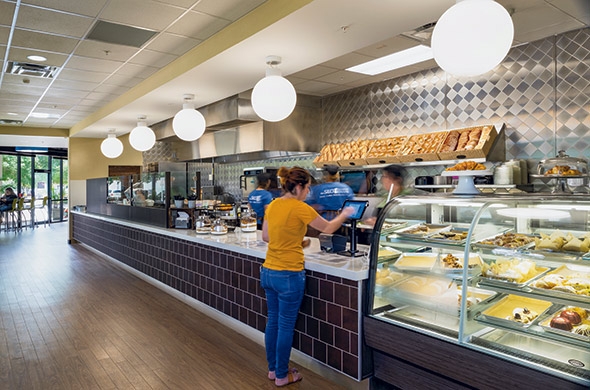 Customers place orders at POS stations at The Silo Eatery. Employees fill their orders and pass menu items over the counter. No doubt this center offers innovative ways to provide food to smaller schools, enhanced catering services to the community and training opportunities to Hillsborough County employees. This facility also offers a solution to rising labor costs and assists in maintaining high-quality food, nutrition and customer services. A win-win for all.
Customers place orders at POS stations at The Silo Eatery. Employees fill their orders and pass menu items over the counter. No doubt this center offers innovative ways to provide food to smaller schools, enhanced catering services to the community and training opportunities to Hillsborough County employees. This facility also offers a solution to rising labor costs and assists in maintaining high-quality food, nutrition and customer services. A win-win for all.
Key Players
- Owner: Hillsborough County Public Schools
- Superintendent: Jeff Eakins
- General Manager of Student Nutrition Services: Mary Kate Harrison, Ph.D.
- Architect and Interior Design: Rowe Architects, Tampa, Fla.; Rick Rowe, AIA, president; Steve Williams, AIA, project manager
- Foodservice Design Consultant: Mackesey and Associates LLC, Chicago; Paul A. Mackesey, principal and senior consultant; Bob Feiler, senior project manager
- General Construction Contractor: The Williams Co., Tampa, Fla.
Facts of Note
- Hillsborough County Public Schools: 230 schools; 215,000 students
- Student Nutrition Services: Total student lunches served in the 2017–18 school year: 20,626,041; total student breakfasts served: 12,892,550; total student dinners served: 1,379,296; total summer meals served: 489,143. Free and reduced-price eligible students: 62.3%.
- Center for Nutrition and Culinary Services Opened: Summer 2017
- Scope of Project: A culinary center that consolidates all student nutrition operations under one roof.
Size: 44,523 sq. ft., including: administrative/office space, 18,555 sq. ft.; administrative warehouse, 3,232 sq. ft.; production kitchen, 9,860 sq. ft.; refrigerated storage, 1,096 sq. ft.; bakery production, 750 sq. ft.; and event center, 11,030 sq. ft. (includes large conference room, culinary demo and training area, three multipurpose rooms and ancillary spaces). The Silo Eatery cafe, 1,740 sq. ft.
Seats: Ballroom seats 220 people; 4 training rooms seat an additional 170 people; The Silo Eatery contains 20 indoor and 20 outdoor seats. - School Nutrition Services Annual Budget: $143 million
- Cost of Meal for Full-Pay Students: $2.25 for elementary students and $2.75 for middle and high school students. Every student receives free breakfast; reduced-price students receive a free lunch by the district, waiving the reduced eligibility cost of 40 cents per lunch.
- Center Hours: 7 a.m. to 4:30 p.m., Monday–Friday; event center hours vary based on scheduled events
- Menu Specialties: Breakfast: breakfast breads, chicken/sausage biscuits, blueberry pancakes, yogurt parfaits, breakfast burritos/tacos. Lunch: tacos, Tuscan chicken pasta, rosemary garlic roasted chicken, Cuban quesadilla, teriyaki chicken with lo mein noodles
- Staff: Nutrition department, includes 2,000 employees in 265 sites; Center for Nutrition and Culinary Services, 85 employees
- Equipment Investment: $1.2 million for 95 percent new equipment
- Website: https://www.sdhc.k12.fl.us



